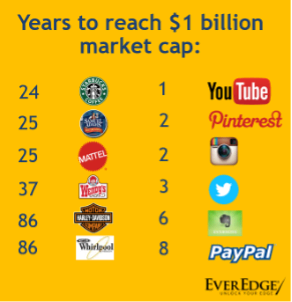Michael Masterson and Massimo Garbuio

Are you leaving money on the table?
COVID-19 is increasing the divide between companies that understand intangible assets and companies that don’t.
The key insight
For many companies, intangible assets have been the remunerative star of the COVID-19 era: data, brand, software, confidential information, trade secrets, trademarks – these are the resources taking centre stage in these economically shocking times.
With the impact of COVID likely to be felt for many years, we will continue to see enterprise value increasingly being driven by intangible assets as companies evolve to leverage platforms, connectivity and data even more intensely. However, if companies want to leverage the COVID lessons to their best advantage, they must do so with some self-awareness.
Today, intangible assets are the primary drivers of company value. They account for more than 90% of all company value and drive virtually all earnings and profit growth, whereas 40 years ago this figure was barely 17%.
Unlike physical assets, digital assets can be scaled exponentially and can offer far greater returns on investment. Universities, to use one handy example, realised their value proposition to students lay not in their physical campuses but in the quality of their teachers as experienced through their bespoke (and swiftly improving) digital learning platforms. The ability to service students anywhere at any time has expanded universities ‘customer base’ whilst simultaneously reducing reliance on physical infrastructure.
In a post-COVID environment, to best leverage these assets and drive value companies must:
- Identify their digital and intangible assets
- Understand the value of their assets and
- Develop an intangible asset strategy to actively mitigate risk and leverage opportunities.
Failing to identify value and protect digital assets appropriately will increase an organisation’s risk of being copied, replicated and made irrelevant. The story of Nokia and Huawei serves as a warning to all, highlighting that companies that outsource, giveaway or sell the critical parts of what they do, then it’s likely competitors will quickly overtake them, leaving their reputation as a sidebar example in a business school text.
Identifying which assets are truly driving profitability within an organisation and developing a comprehensive strategy to maximise the value of these assets will be key to companies extracting value – or to getting higher exit or sale value.
The global pandemic has accelerated many companies’ digital transformations through both necessity and opportunity. As borders closed, supply chains were disrupted and entire cities went into lockdown, many companies were forced to re-evaluate their business models and explore alternative ways to generate new revenue streams.
Transformation happened almost overnight for many companies. As management teams looked for ways to pivot, digital and intangible (such as data, brand, software, confidential information, trade secrets, patents and trademarks) suddenly took centre stage as it quickly became clear that this is where the value lay for many companies.
With the impact of COVID likely to be felt for many years, we will continue to see enterprise value being driven even more by intangible assets as companies evolve to leverage platforms, connectivity and data even more heavily. However, if companies want to take the lessons learned during COVID and leverage these to their advantage, they need to do so with some self-awareness.
Intangible assets doing the heavy lifting when it comes to value
Today, intangible assets are the primary drivers of company value. These assets account for more than 90% of all company value and drive virtually all earnings and profit growth, whereas 40 years ago this figure was barely 17%.
While there is a perception that by being digital companies can cut costs, be more productive and reach more customers, the real opportunities extend far beyond this. Unlike physical assets, digital assets can be scaled exponentially and can offer far greater returns on investment at a faster rate.

Think this through. If you look at a board room table, there is a definite relationship between the inputs to the table and its value. The table will never be worth a billion dollars, but the outcomes of the discussions that happen around it might well be.
Universities are another example. Traditionally universities invested in large physical campuses and focus recruitment was on the local catchment area or, more recently, high-value overseas students who would physically relocate to the campus location. However, today the power is really in the hands of the customer, with more and more students choosing to learn remotely at times and locations of their own choosing. Universities are transitioning from local competition for domestic students to Australia-wide competition.
This trend, apparent pre-COVID, has been expedited over the past 12-months, with universities and other learning institutions forced to adopt technology to better enable digital learning and interaction experiences for their students. In addition to removing geographical barriers to entry (students have the potential to learn from anywhere at anytime), this move towards a more digital learning environment may also result in a reduced reliance on physical assets such as buildings or human assets (because recorded material can be reused) thereby reducing costs and making education more accessible for all.
Universities are not an outlier. Today, every business has intangible assets: consider a small Sydney-based manufacturer located in a one of the city’s industrial parks. While at first glance, a business such as this might look predominantly tangible, it will be loaded with intangible assets: product designs, customer data, supplier relationships, regulatory approvals, brands, and a whole variety of other intangible assets that contain value.
So, in a post-COVID environment, how can companies continue to leverage these assets to drive value?
It comes down to three steps:
1. Identify your digital and intangible assets
First, undertake an audit, identifying all digital and intangible assets, and secondly, assess how these assets drive economic and strategic value for the business.
This sounds obvious, but many companies don’t even understand what assets they own or the true value of many of their assets. Unfortunately, under current accounting standards intangible assets are effectively ignored. They are either off balance sheet, lost under the amorphous term ‘goodwill’ or, if they do make the balance sheet, they are recorded at cost. This can significantly distort and hide where value lies within an organisation.
Take for example an internet company we worked with recently as it prepared for a micro-cap $50M IPO. As part of this process, EverEdge conducted an audit of its assets and identified an under-valued intangible asset, which had been purchased at $1M but depreciated to $0.5M under GAAP. After analysis of the market, three similar assets were identified, which had each sold for $50m. The company was taken through a process to sell and license back the asset, which released $50m in cash to the shareholders.
2. Understand the value of your assets
Next, work out what each asset is worth – either in your hands or in someone else’s.
Valuing digital and intangible assets requires the assessment of a much broader range of factors than are generally included in traditional valuations. Things like the underlying quality of the intangible assets (for example, the nature of software code; how current and relevant the data is; the breadth of a patent etc.), as well contextual factors such as the leverage or benefit those intangible assets will deliver to different potential buyers, investors or partners. With intangible assets the whole is typically worth more than the sum of its parts, so analysis of the interaction of all these assets grouped together is essential.
Take, for example, Instagram. When Instagram was sold to Facebook in 2012, the company was 20 months old, had no revenue, effectively no assets and 12-employees. Traditional Cost or Cash Flow Basis methods (which focus on the balance sheet) would have said this company was worth $0 yet it was sold to Facebook for $1 billion. Fast forward to today, and Bloomberg Intelligence estimates Instagram would be worth more than $100 billion if it were its own company and not a Facebook division.
Facebook acquired Instagram not for 12 employees or its laptops and chairs or its non-existent cashflow, but for its intangible assets: its brand, its data, and its fast-growing user base. In this case, Instagram’s intangible assets solved a major issue for Facebook, which led to the value of Instagram’s assets bearing little relationship to the economic value that its business was generating at the time it was sold.
Instagram’s value, like most start-ups and growth orientated companies, was in its intangible assets. This is why it is important to look beyond the balance sheet when assessing value: if conventional company valuation approaches had been used, these assets would have largely been ignored and their value hidden.
If you start from the balance sheet or even traditional methods, you are anchoring your next evaluation to the first number that has been generated, which does not really work in your favour.
When assessing the value of your own assets, ask yourself:
3. Develop an intangible asset strategy to actively mitigate risk and leverage opportunities
Companies that actively manage their intangible and digital assets have the potential to leverage these assets to assist them to grow faster, increase market share and margins, and outperform their peers. Companies that fail to identify and actively leverage their intangible assets run an increased chance of their financial performance declining; their competitive advantage being lost; and an increased vulnerability to major risks such as the loss of confidential information and an inability to establish chain of title to their intangible assets.
This is because by understanding what assets the company owns, along with the value of these assets and the risks associated with them, management teams are better able to determine which ones are driving the company’s competitive advantage, which in turn will dictate where they want to focus time and resources.
In this phase, ask yourself:
- How can we unlock additional value from our intangible assets?
- Do our employees and management teams understand how important these assets are?
- What is our strategy to manage and mitigate these risks?
- What systems and processes do we have in place to manage these risks?
So why does this all matter, now more than ever?
By not identifying, valuing and protecting your digital assets appropriately, you end up being copied, replicated and made irrelevant. The story of Nokia and Huawei serves as a warning to all, highlighting that if you outsource, giveaway or sell the critical parts of what you do, then it’s likely your competitors will quickly overtake you while you become a sidebar example in a business school text.
Identifying which assets are truly driving profitability within your organisation and developing a comprehensive strategy to maximise the value of these assets will be key to companies extracting value – or to getting higher exit or sales value.
This is part of a series of insights related to Coronavirus (COVID-19) and its impact on business.
Michael is the Managing Director of Australia and New Zealand at EverEdge, a global intangible asset advisory, valuation and transaction specialist. Michael helps companies and investors unlock their competitive edge by identifying, valuing and monetising their intangible assets.
Dr Massimo Garbuio is an Associate Professor in Entrepreneurship at the University of Sydney. He's passionate about helping students and business leaders become master strategists.
Share
We believe in open and honest access to knowledge. We use a Creative Commons Attribution NoDerivatives licence for our articles and podcasts, so you can republish them for free, online or in print.





